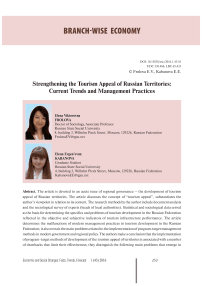Strengthening the tourism appeal of Russian territories: current trends and management practices
Автор: Frolova Elena Viktorovna, Kabanova Elena Evgenevna
Журнал: Economic and Social Changes: Facts, Trends, Forecast @volnc-esc-en
Рубрика: Branch-wise economy
Статья в выпуске: 1 (43) т.9, 2016 года.
Бесплатный доступ
The article is devoted to an acute issue of regional governance - the development of tourism appeal of Russian territories. The article discusses the concept of “tourism appeal”, substantiates the author's viewpoint in relation to its content. The research methods by the author include document analysis and the sociological survey of experts (heads of local authorities). Statistical and sociological data served as the basis for determining the specifics and problems of tourism development in the Russian Federation reflected in the objective and subjective indicators of tourism infrastructure performance. The article determines the malfunctions of modern management practices in tourism development in the Russian Federation; it also reveals the main problems related to the implementation of program-target management methods in modern government and regional policy. The authors make a conclusion that the implementation of program-target methods of development of the tourism appeal of territories is associated with a number of drawbacks that limit their effectiveness; they distinguish the following main problems that emerge in the implementation of the federal target program “Development of domestic and inbound tourism in the Russian Federation (2011-2018)”: financial risks; the declarative principle of selection of regions for participation in the federal target program; focus on the achievement of economic indicators - these problems make it difficult to assess the long-term prospects of aspects of tourism appeal such as the creation and/or development of unique tourist attractions, the image of a territory, high threshold values of co-financing of expenditure obligations to implement the programs for regional budgets...
Tourism, tourism appeal, tourist potential, management practices, management system, local governments, program-target method
Короткий адрес: https://sciup.org/147223798
IDR: 147223798 | УДК: 338.486 | DOI: 10.15838/esc/2016.1.43.10
Текст научной статьи Strengthening the tourism appeal of Russian territories: current trends and management practices
Introduction. Tourism in modern conditions is one of the most dynamic and lucrative sectors of the economy, providing an influx of investment, new job and strengthening small and medium-sized businesses. At the same time, tourism fulfils social functions, such as creation of conditions to realize people’s needs in rest, and familiarization with historical and cultural values, history, religion, and traditions [15, p. 3]. The analysis of recent trends in the tourism industry development in Russia leads to the conclusion that by some indicators there was an increase in the number of tourist infrastructure objects. Thus, according to the Federal State Statistics Service of the Russian Federation, the number of hotels and similar accommodation facilities grew 1.5-fold (6,774 in 2008 and 9,855 in 2013) [20]. However, according to the results of sociological research, the level of Russia’s tourist attractiveness in the estimates of population is quite low.
Experts note ‘the decline in efficiency of tourism functioning in all, even advanced, regions of the Russian Federation, which necessitates the search for new anti-crisis models of tourism organization”[12, p. 4]. The key factors hindering the promotion of tourism in Russia are still undeveloped tourist infrastructure, slow pace of development and improvement of its main elements: transport system, accommodation facilities and food, as well as quality and price of services provided [11, p. 3]. The Federal State Statistics Service of the Russian Federation records the negative dynamics of changes in the number of tourist infrastructure objects, such as holiday centers and boarding houses with treatment ( fig. 1 ) [20].
The indicators characterizing the development of tourist infrastructure for children seem rather pessimistic. Thus, the number of children’s health institutions decreased by 10% over the last 5 years ( fig. 2 ) [20].
Figure 1. Dynamics of changes in the number of holiday centers and boarding houses with treatment
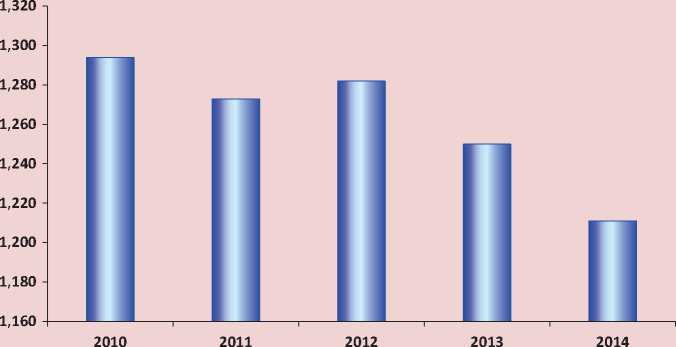
Source: Sotsial’no-ekonomicheskie pokazateli Rossiiskoi Federatsii v 1991– 2014 gg. Kul’tura, otdykh i turizm [SocioEconomic Indicators of the Russian Federation in 1991–2014. Culture, Recreation and Tourism]. Federal’naya sluzhba gosudarstvennoi statistiki [Federal State Statistics Service]. Available at:
Figure 2. Number of children’s health institutions, thousand
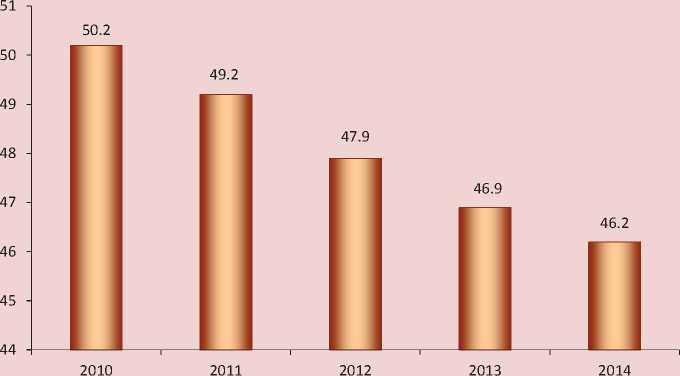
Source: Sotsial’no-ekonomicheskie pokazateli Rossiiskoi Federatsii v 1991– 2014 gg. Kul’tura, otdykh i turizm [SocioEconomic Indicators of the Russian Federation in 1991–2014. Culture, Recreation and Tourism]. Federal’naya sluzhba gosudarstvennoi statistiki [Federal State Statistics Service]. Available at:
These trends severely hinder the development of tourism in our country and reduce the level of competition in the industry. For the last 4 years the number of objects of tourist infrastructure of economy class decreased by 10%, particularly resorts and campsites (1,687 in 2010 and 1,515 in 2014). The rapid decline in the number of institutions of cultural and leisure type is particularly alarming – by 5 thousand units in recent years, and since 2003 – by more than 10 thousand [20]. Thus, this problem is relevant due to the contradiction between the high socioeconomic importance of tourism and the insufficient level of its development in modern Russian conditions.
Methodology and method. The theoretical issues and the analysis of conceptual framework of the functioning and promotion of tourism and tourist infrastructure are reflec-ted in the works of such scientists, as A.Yu. Aleksandrova [1], M.B. Birzhakov [3], A.V. Velichkina [5], I.V. Zorin, V.A. Kvartal’nov [13], A.I. Shishkin [26], H. Godfrey [8], B. Dellaert, Arentze T., O. Horeni [28], H. Hilman, N. Kaliappen [29], M. Landauer, W. Haider, and U. Probstl-Haider [30]. The analysis of regional aspects of tourism development and characteristics of tourist activity is conducted by S.V. Dusenko [10], L.A. Golubchikova [9], S.E. Shcheglov [27], and A.S. Kuskov [16]. However, the mentioned works pay insufficient attention to the analysis of activity of the subject who manages tourism development processes and directions to optimize of interaction of federal, regional and local authorities. A significant number of recent works are dedicated to territories’ tourist attractiveness and its formation factors [4; 6; 19]. These studies present an analysis of socio-economic, marketing strategies of tourism development. But, in our opinion, the elaboration of recommendations on the enhancement of Russian regions’ tourist attractiveness should be based on the analysis of existing management practices, their resource provision and most significant constraints. In this context, it is interesting to consider results of the survey of population, as well as heads of local authorities directly involved in the development of tourism industry of the municipality and the decision of problems of the tourist infrastructure functioning.
The analysis of scientific publications in terms of tourism development leads to the conclusion that a number of works quate the concepts “tourist attractiveness” and “tourist potential”. Let us note that, in our opinion, tourist potential is only a precondition for tourist activity organization, including components, such as objects of historical, socio-cultural heritage, natural resources, while tourist attraction is already a result of relevant activities to improve tourist potential and create appropriate tourist infrastructure. Tourist attractiveness is a characteristic of the territory, reflecting the demand for territorial tourist services and the related level of tourist needs satisfaction [14, p. 17].
This article analyzes the problems to form and develop tourist attractiveness of Russian regions, the major activities of the federal, regional and local authorities in this sphere, the constraints and prospects of tourism development in modern conditions. The information base of research is the following: federal and regional normative legal acts, statistical data, information and analytical materials of federal, regional and local authorities. The paper also uses the results of the study “Development of tourism and cultural potential of municipal entities of the Russian Federation”. The research was conducted in February–May 2015 by means of questionnaires distributed via the Internet by the All-Russian Council of Local SelfGovernment (with the authors’ participation). The sample included 514 experts (heads of the local authorities of RF municipal formations). The work was aimed at analyzing the resources and constraints in the formation and development of tourist attractiveness of the RF municipalities. The sampling was multi-level, territorial, and casual. At the first stage 76 RF subjects were identified as selection units. The list of municipalities was taken as a sampling frame at the second stage. The sample of municipalities by federal districts reproduced the structure of general population in proportion to the number of municipalities in the district.
To analyze the population’s estimates we used the results of the research conducted by the Russian Public Opinion Research Center (VCIOM) and the Fund “Public Opinion” (FOM).
Results. At the federal level the authorities’ activities in terms of tourism development are focused on the implementation of programtarget methods. The federal target program “Development of domestic and inbound tourism in the Russian Federation (2011– 2018)” (hereinafter – the Program) is considered as the main tool. The quantitative certainty of the set target indicators is clearly stated: for example, 1.9-fold growth of investment in fixed capital; 1.5-fold increase in the number of Russian citizens placed in collective accommodation facilities; 4.7-fold rise in the volume of paid tourist services, provided to population and 4.3-fold increase in the volume of paid services of hotels and similar accommodation (compared with 2010) [21].
According to the analysis, the effectiveness of the Program is measured primarily through the indicators of tourist infrastructure development (growth of fixed capital investment in accommodation facilities, increase in the number of workers in collective accommodation facilities and tourist companies). At the same time, the indicators describing the development of tourist potential of the territory (modernization and reconstruction of cultural and historical sites, restoration and conservation of natural and recreational potential, construction and improvement of leisure facilities) are not stipulated in the Program. However, the creation of a network of competitive tourist clusters (stated as a Program goal) involves the development of appropriate infrastructure and tourist attraction objects, forming the basis for tourist attractiveness of the territory. Let us also note that the evaluation of the Program effectiveness includes, primarily, economic indicators, such as growth in the volume of paid tourist services and rise in the number of Russian and foreign citizens, placed in hotels and places for temporary accommodation. In our opinion, the assessment of efficiency of the competitive tourist market formation in the country should not be limited to the features of the paid tourist services. It is more significant to estimate activities, such as creation and/ or development of unique objects of tourist attraction, preservation and actualization of historical and cultural heritage objects, innovative ideas, development of event tourism, and modernization of practices to realize tourist products in the sphere of folklore, folk crafts, and local initiatives. The competitiveness of regional tourist products is composed of the characteristics of functioning of both objects of tourist infrastructure and objects of tourist potential of recreational and cultural orientation.
The Program pays insufficient attention to the indicators of information provision of tourist attractiveness development. The functioning of relevant regional information and travel portals is the most effective factor in the promotion of territorial tourist products to international and domestic markets, ensures the presentation of cultural, historical and recreational potential, advertising and sale of tourist products and services. In our view, the growth in the number of regional tourist information portals is one of the priorities in modern conditions, and, accordingly, this indicator (given its clear quantitative certainty) can be considered in the elaboration of final results of the Program realization.
In the framework of financial provision of the Program activities we can single out a specific problem, such as established thresholds for programs co-financing on the part of regions. Most regions get subsidies. So, in terms of the measures to boost domestic and inbound tourism the level of co-financing of RF subject’s expenditure commitments can not be lower than 5% [21].
The application-based principle of selecting regional projects for participation in the federal target program also hinders effective implementation of the Program. In this context, we can consider not so much tourist potential of the territory, as initiative of the RF subject’s authorities and its economic opportunities to participate in co-financing as the decisive factor in raising funds for regional projects of tourism promotion. This limits the selection of regions that, in fact, have unique tourist-recreational resources and potential to increase domestic and foreign demand for tourist services. In order to improve the efficiency of state support of tourism development it is appropriate to take measures, such as monitoring Russian regions’ tourist and recreational potential, making comparative rankings of regions in terms of both real and potential competitiveness of rendered tourist services, and promoting territorial tourist products. Let us note that in 2011–2014 the key Program activities include “monitoring of the availability, level of development and availability of regional tourist and recreational resources”. However, due to a lack of the generally accepted methodology of system evaluation of these indicators it is very difficult to obtain relevant and objective information. In our opinion, the monitoring of RF subjects’ tourist and recreational potential should result in public information, objective ratings of regional tourist resources. In order to ensure the maximum transparency of the procedures of making these ratings, consider both quantitative and qualitative indicators it is reasonable to use the methods of expert evaluation, social studies, taking into account tourist preferences of potential service consumers.
The instability of budgetary financing of the Program activities is one of the most significant economic risks in its implemen- tation. So, the total amount of funding of the federal target program “Development of domestic and inbound tourism in the Russian Federation (2011–2018)” was reduced by 2.4 times in comparison with the originally planned estimates (from 332 billion rubles to 139.5 billion rubles). The co-financing was decreased at the expense of the regions, local budgets and extra-budgetary sources of financing, primarily, due to certain problems in the Russian economy [7]. According to the survey of experts, heads of local authorities, the financial constraints reduce the effectiveness of management activities to the greatest extent (fig. 3). Evaluating resources for the development of tourist attractiveness of the municipality, 89.1% of the experts note the shortage of financial resources.
Figure 3. Resource assessment of municipalities’ tourist attractiveness, according to the survey of experts, %
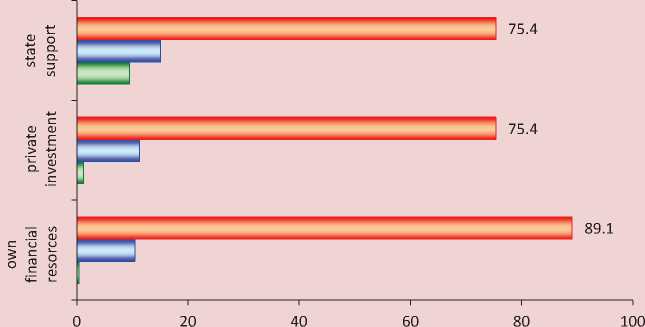
□ insufficient □ sufficientbutnotenough □ sufficient
In addition, the regional reports on the 2014 results illustrate the problem of a long process of approval and adoption of budget allocations and receipt of funds. In some cases, the given federal revenues went into the regional budget very late (December 2014). As a result, the funds could not be utilized and were returned to the federal budget.
Thus, the main problems of realization of the federal target program to develop domestic and inbound tourism are the following:
– focus on the achievement of economic indicators, which do not take into account the strategic perspectives of tourist attraction aspects, such as creation and/or promotion of unique objects of tourist attraction, image of the territory;
– priority of the purposes to enhance tourist infrastructure, lack of indicators characterizing the level of development of the territory’s tourist potential;
– lack of indicators providing information on tourism development (for example, number of regional information-travel portals);
– high threshold of co-financing of expenditure obligations to implement programs for regional budgets;
– application principle to select regions for participation in the federal target program;
– long process of negotiation and financing – the complex hierarchical funding system causes a significant loss of time and a high level of risks in the process of planned activities implementation;
-
– financial risks of financing the Program in the unstable socio-economic conditions;
– limited opportunities for adjusting programs; the provision of conditions for adjusting program objectives and activities seems necessary, given the programs’ variable nature and the appearance of additional possibilities and resource constraints;
– absence of the effective system to evaluate and monitor the implementation of programs, low level of public participation in their elaboration and the process of control over funds expenditure.
Key trends and problems of development of tourist attractiveness of Russian territories. The identified dysfunctions in the implementation of program-target methods result in the low achievement of stated results, the cost overrun in the measures realization and, moreover, the inflated volume of attracted federal funds.
The city of Sochi in Krasnodar Krai is a bright example of this practice. When preparing for the 2014 Winter Olympics the Program’s budget was initially estimated at 327 billion rubles, but the total costs exceeded the stated estimates by five times and amounted to 1.5 trillion rubles. The implementation of the infrastructure project (roads, bridges, tunnels, hotel facilities, train stations, sea port, etc.) required 1.3 trillion rubles, of which 400 billion rubles from the federal budget and 900 billion rubles of attracted investments [18]. The infrastructure upgrade enables the city to develop the possibilities of summer vacation, open new ski runs and expand the therapeutic profile of the treatment cluster, helping Sochi to withdraw completely from the seasonality factor and become a multi-functional resort. However, the complex of activities does lead to a higher volume of tourist flow, primarily due to the high cost of provided tourist services [25]. These findings are confirmed by the sociological research. Judging by the survey results (1,600 people were polled in March 2014), the vast majority of Russians (76%) do not plan tourist trips to Sochi (fig. 4) [2].
Despite the wide information support and coverage of the Winter Olympics, the level of tourist attractiveness of Sochi is quite low: for example, 41% of the respondents are not eager to visit this resort after the 2014 Olympics. More than half of the respondents (53%) do not recommend recreation in Sochi due to its high cost [2].
Overall, the insufficient level of tourist attractiveness of Russian territories is confirmed by the results of opinion polls. So, according to VCIOM (1,600 people were surveyed in June 2011), answering the question “What country would you like to visit?” 20% chose the option “France”, 19% – “Italy”, 12% – “Germany”, “Turkey”, 11% – “Egypt”, and 10% – “Spain”. Russia was at the bottom of the ranking of most attractive travel destinations [2]. According to FOM (1,500 people were polled in June 2011), 39% of the Russians have never traveled around Russia. 68% of the respondents do not intend to have a rest in any Russian regions in the coming year [22]. Let us note that the economic crisis, currency fluctuations, the unstable foreign policy situation make the Russians change their travel plans somehow. At the end of the 2015 summer holidays,
Figure 4. Distribution of answers to the question: “Are you going to go to Sochi or not?”, %
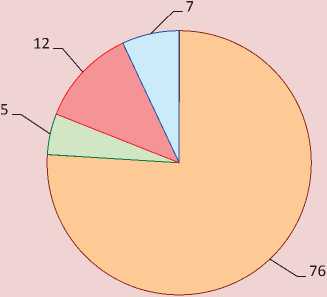
-
□ do not plan
-
□ in the coming year
-
□ in 2 years or later
-
□ difficult to answer
Source: VCIOM base data. Available at:
according to the surveys, there was a decrease in the percentage of respondents vacationing abroad. Meanwhile, domestic travel became more popular, particularly to the resorts of Krasnodar Krai and the Crimea. In addition, according to the VTCIOM poll (conducted in 2015 after announcing a ban on flights to Egypt), two-thirds of the Russians (67%) mention that the Russian authorities should focus their efforts on the improvement of domestic tourism, but not on the safety of foreign travel [2].
According to the August 2013 survey (FOM polled 1,500 respondents), the low public awareness of tourist opportunities, the Russian regions have, hinders the development of domestic tourism. So, almost every third inhabitant of the country can not name the main attraction of the Russian Federation. Eight percent of the respondents believe that in Russia there are no places they would like to visit; one in five (22%) find it difficult to answer the question [22].
The obtained results are confirmed by the expert survey data. So, the local authorities consider the insufficient level of information and advertising support of local tourist potential as a key obstacle in the enhancement of tourist potential of the area (the experts identify 2 problems: potential consumers’ ignorance of the opportunities of tourist attraction in the municipality and lack of funds for advertising) ( fig. 5 ).
Figure 5. Distribution of answers to the question: “Please, identify the main problems that hinder the development of tourist potential in your municipality”, %
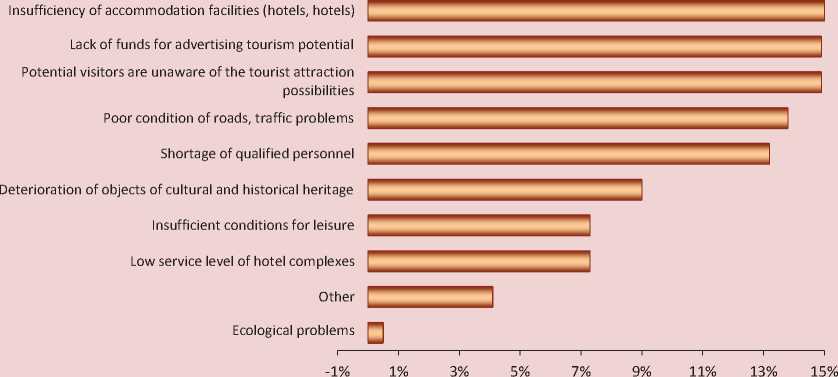
The insufficient level of tourist infrastructure development and the disparity of price and quality of services provided also hamper the development of Russian regions’ tourist attractiveness. The regular surveys conducted by the all-Russian sociological services help identify the unsatisfactory state of infrastructure in the Russian territories, its non-compliance with people’s needs and the presence of so-called territorial inequality, namely unequal access to certain social goods and services for people of various regions and types of settlements [23].
In modern conditions for the majority of municipalities the infrastructure problems are a major cause of declining competitiveness on the tourist market. The statistical data are confirmed by the expert survey results. More than half of the surveyed local authorities (51.8%) indicate the insufficient number of accommodation facilities (hotels, hostels). In addition, the experts give very low estimates of accommodation quality in hotel complexes on the territory of municipal formations.
Discussion . Thus, although the federal government allocates substantial funding, the level of tourist attractiveness of Russian regions is quite low. The analysis of modern trends in domestic tourism development in the Russian Federation allows us to single out most critical problems: deficit of local budgets, lack of funds for advertising Russian regions’ tourist potential, people’s low awareness about tourist opportunities in Russian municipalities, infrastructure problems, and mismatch ratio of price and tourist services quality.
At the same time, a number of problems in the implementation of the federal target program “Development of domestic and inbound tourism in the Russian Federation” significantly downgrade the level of Russia’s tourist attractiveness. The concentration of financial and economic mechanisms and control power at the federal level negatively affects the organizational activity parameters in this field. In our opinion, it is possible to solve the problem by enhancing the interaction of federal, regional and local authorities. The activities of federal administrative bodies should be, primarily, aimed at creating the motivation system, ensuring the high efficiency of management practices to boost tourism at the regional and local level. Effective tourism development should be a priority of local authorities; they have a greater number of opportunities for assessment of tourist potential, identification of problems in the tourist industry, rapid response, monitoring of funds utilization, and attraction of private investors. Local authorities are closest to economic entities, have greater abilities to develop innovative and unique ideas in a particular area, interact with the public, and support action teams.
The public policy transition from direct intervention to indirect regulation of tourism development involves changes in the centralization degree in the inter-budgetary relations. The analysis of the RF budget system does not clear up the principles of tax revenue distribution among budgets of different levels. The federal tax structure is determined mainly by the yield factor, since it mostly includes tax payments, which provide the largest amounts of fiscal revenues. The deficit of local budgets is steadily increasing (more than twice): from 52.4 billion rubles in 2007 to 125.5 billion rubles in 2013. The analysis of budgetary legislation norms and statistical data allows us to draw a conclusion about artificial subsidization of both RF subjects and municipal entities. The withdrawal of the vast majority of tax revenues to the higher budgets and then their return in the form of inter-budgetary transfers lead to the maintenance of the high level of power centralization and dependence of local governments on regional and federal. Transfers go to both objectively weak municipalities and those that have a stable tax base and could have financial autonomy in resolving local issues provided that the standards of tax deductions are changed. Such a policy limits the motivational mechanisms for the implementation of own socio-economic potential of modern municipalities [24, p. 354].
Thus, when changing the budgetary centralization policy, the federal authorities should focus primarily on the creation of motivation systems, ensuring the effectiveness of management practices to develop tourism at the regional and local level. For example, the transfer of powers to form a material and financial resource base from the center to the local level could be productive. Such successful experience is observed in the developed foreign countries, such as Italy, France, USA, Austria,
Poland, the Netherlands, UAE, Spain, Switzerland, and Montenegro, where tourist tax is introduced. Levied funds go to the city budget and are used for the development of tourist potential of the area. So, for example, 60% of the funds, Zurich gets to promote tourism, are received at the expense of tourist tax.
As for the regional authorities’ key tasks in the sphere of tourism development, they could assist local authorities of municipal formations in reconstruction, maintenance and restoration of monuments of cultural and historical heritage, formation of tourist clusters, and enhancement of transport infrastructure. The activities of regional authorities that promote tourist attractiveness include the creation of conditions for inter-municipal cooperation in the field of construction of major tourist infrastructure facilities and transport communications.
Information and methodological support is a topical issue within the framework of the regional authorities’ activities. It involves the publication of booklets, brochures and memos for tourist market participants and the conduct of conferences, exhibitions and seminars on experience exchange, joint meetings with representatives of regional and local authorities, private investors and population. For example, in the Leningrad and Vologda oblasts there are schools for the development of rural tourism, which hold seminars with representatives of tourist industry and heads of local administrations. In the Ulyanovsk Oblast the regional authorities held a rally “Live and rest on the Volga”, aimed at attracting area residents to relax at boarding houses, holiday centers and rest homes of the region [17].
Conclusions. The analysis of statistical and sociological data helps identify key trends in the development of tourist attractiveness of RF territories, as well as basic problems of programtarget management methods realization. The identified constraints of domestic tourism improvement, on the one hand, expand knowledge in the field of scientific support of the economy of territories, and on the other hand, have practical importance, helping identify areas for managerial improvement in the industry. The article presenting practical recommendations for improving interaction of federal, regional and local authorities can serve as the conceptual basis for the development of Russia’s tourist attractiveness. The article substantiates the conclusion that the consolidation of efforts of local authorities, business and population at the municipal level is most effective management measure to form and promote tourist attractiveness. The priority directions of administrative activity are the following: creation and/or development of unique objects of tourist attraction, updating of objects of cultural and historical heritage, search and implementation of innovative ideas devoted to event tourism, and modernization of practices to create tourist products and services in the field of folklore, folk crafts, local initiatives.
Список литературы Strengthening the tourism appeal of Russian territories: current trends and management practices
- Aleksandrova A.Yu. Mezhdunarodnyi turizm . 2nd edition, revised and supplemented. Moscow: KNORUS, 2010. 464 p.
- Baza sotsiologicheskikh dannykh VTsIOM . Available at: http://wciom.ru/zh/print_q.php?s_id=953&q_id=65438&date=16.03.2014
- Birzhakov M.B. Vvedenie v turizm . Saint Petersburg: Gerda, 2014. 544 p.
- Vazhenina I.S. O sushchnosti brenda territorii . Ekonomika regiona , 2011, no. 3, pp.18-23.
- Velichkina A.V. Otsenka razvitiya turistskoi infrastruktury regiona . Ekonomicheskie i sotsial'nye peremeny: fakty, tendentsii, prognoz , 2014, no. 2, pp. 239-250.
- Vinogradov A.V. Metodicheskie osnovy upravleniya turisticheskim potentsialom regiona (na primere Sankt-Peterburga i Leningradskoi oblasti): avtoref. dis.. kand. ekon. nauk . Saint Petersburg, 2010. 22 p.
- Vystuplenie Medvedeva D.A. na zasedanii Pravitel'stva 11.12.2014 . Available at: http://government.ru/news/16073/
- Godfrey H. Stimulirovanie mezhdunarodnogo turizma v XXI veke . Ed. by V.A. Kvartal'nov; translated from English by E.V. Moshnyag. Moscow: Finansy i statistika, 2009. 237 p.
- Golubchikova L.A. Sanatorno-kurortnyi kompleks Rossiiskoi Federatsii: sotsiologicheskii analiz: dis.. kand. sots. nauk . Moscow, 2004. 166 p.
- Dusenko S.V. Struktura i funktsiya sotsial'nogo prostranstva turizma (sotsiologicheskii analiz): dis.. d-ra sots. nauk . Moscow, 2014. 337 p.
- Evreinov O.B. Kompleksnoe razvitie i sovershenstvovanie infra-struktury turizma v regione: avtoref. dis.. kand. ekon. nauk . Saint Petersburg, 2012. 24 p.
- Zabaeva M.N. Effektivnoe ispol'zovanie regional'nogo turistskogo potentsiala: teoriya, metodologiya, praktika: avtoref. dis.. d-ra ekon. nauk . Nizhny Novgorod, 2011. 49 p.
- Zorin I.V., Kvartal'nov V.A. Entsiklopediya turizma . Moscow: Finansy i statistika, 2014. 368 p.
- Kabanova E.E. Turisticheskaya privlekatel'nost' munitsipal'nykh obrazovanii kak predmet mezhdistsiplinarnykh issledovanii . Vestnik natsional'noi akademii turizma , 2015, vol. 33, no. 1, pp. 15-19.
- Karnaeva E.E. Razvitie predprinimatel'skoi deyatel'nosti v sotsial'noi sfere (na primere gorodskikh turistskikh kompleksov malykh gorodov Severo-Zapada Rossii): avtoref. dis.. kand. ekonom. nauk . Saint Petersburg, 2008. 21 p.
- Kuskov A.C., Arsen'eva E.H. Ekoturistskii potentsial osobo okhranyaemykh prirodnykh territorii i problema ego ispol'zovaniya . Sovremennyi gorod: sotsiokul'turnye i ekonomicheskie perspektivy: mezhvuz. sb. nauch. st. po itogam Vseros. nauch.-prakt. konf., Saratov, 2004 g. . Pp. 257-260.
- Makatrova N.S. Kak mestnye i regional'nye vlasti mogut pomoch' v razvitii turizma . Kurortnoe delo, turizm i rekreatsiya , 2009, no. 3, pp. 26-32.
- Skol'ko stoit podgotovka k Olimpiiskim igram v Sochi? . AiF , 2013, no. 43. Available at: http://www.aif. ru/infographic/1009874
- Slavin V.V. Turisticheskaya privlekatel'nost' regiona: ponyatie, soderzhanie, osnovnye printsipy formirovaniya . Voprosy upravleniya , 2013, vol. 22, no. 1, pp. 108-113.
- Sotsial'no-ekonomicheskie pokazateli Rossiiskoi Federatsii v 1991-2014 gg. Kul'tura, otdykh i turizm . Federal'naya sluzhba gosudarstvennoi statistiki . Available at: http://www.gks.ru/bgd/regl/b15_13_p/Main.htm
- Federal'naya tselevaya programma “Razvitie vnutrennego i v»ezdnogo turizma v Rossiiskoi Federatsii (2011-2018 gody)” . Konsul'tantPlyus .
- Fond obshchestvennogo mneniya . Available at: http://fom.ru/Mir/10027
- Frolova E.V. Sotsial'naya infrastruktura sovremennykh rossiiskikh munitsipal'nykh obrazovanii: sostoyanie i resursy modernizatsii . Sotsiologicheskie issledovaniya , 2014, vol. 368, no.12, pp. 51-58.
- Frolova E.V. Deformatsii mezhbyudzhetnykh otnoshenii v Rossiiskoi Federatsii: sotsial'no-ekonomicheskie i politicheskie riski . Aktual'nye problemy ekonomiki , 2014, no. 8, pp. 351-359.
- Chto budet s olimpiiskimi ob»ektami posle 2014 goda? . Informa-tsionno-analiticheskoe agentstvo “Delovye novosti” . Available at: http://delonovosti.ru/main/1864-chto-budet-s-olimpiyskimi-obektami-posle-2014-goda.html
- Shishkin A.I., Biktimirova E.D. Metodicheskie osnovy sozdaniya turistsko-rekreatsionnogo klastera “Zaonezh'e” (Respublika Kareliya) . Ekonomicheskie i sotsial'nye peremeny: fakty, tendentsii, prognoz , 2013, no. 2, pp. 74-86.
- Shcheglov S.E. Dinamika i tendentsii razvitiya turizma v Rossii . Sotsial'naya politika i sotsiologiya , 2004, no. 2, pp. 175-176.
- Dellaert B., Arentze T., Horeni O. Tourists' Mental Representations of Complex Travel Decision Problems. Journal of Travel Research, 2014, no. 53, pp. 3-11.
- Hilman H., Kaliappen N. Market Orientation Practices and Effects on Organizational Performance Empirical Insight From Malaysian Hotel Industry. SAGE Open, 2014, no. 4 (4).
- Landauer, M., Haider, W., Pröbstl-Haider, U. The Influence of Culture on Climate Change Adaptation Strategies: Preferences of Cross-Country Skiers in Austria and Finland. Journal of Travel Research, 2014, no. 53, pp. 96-110.

